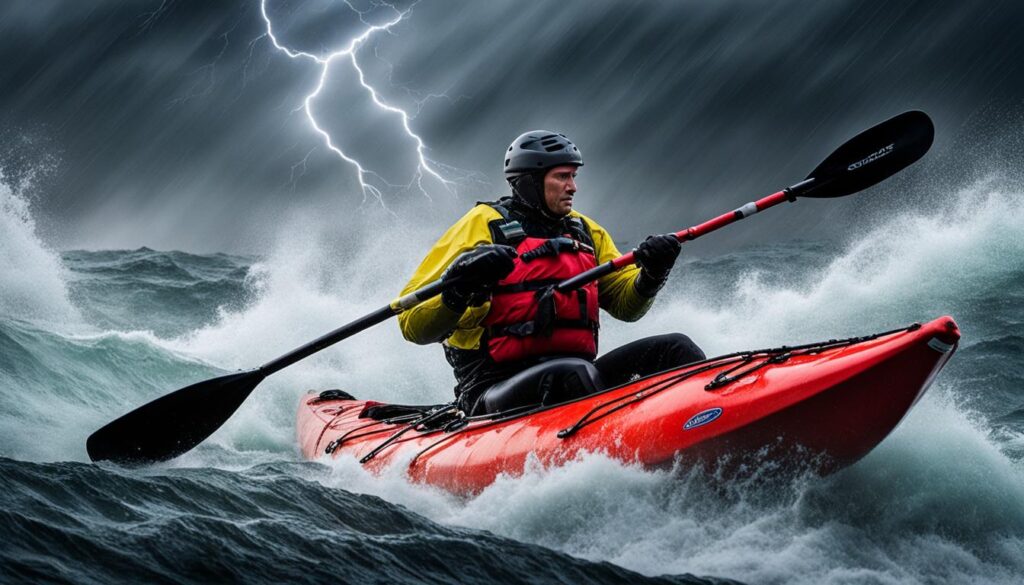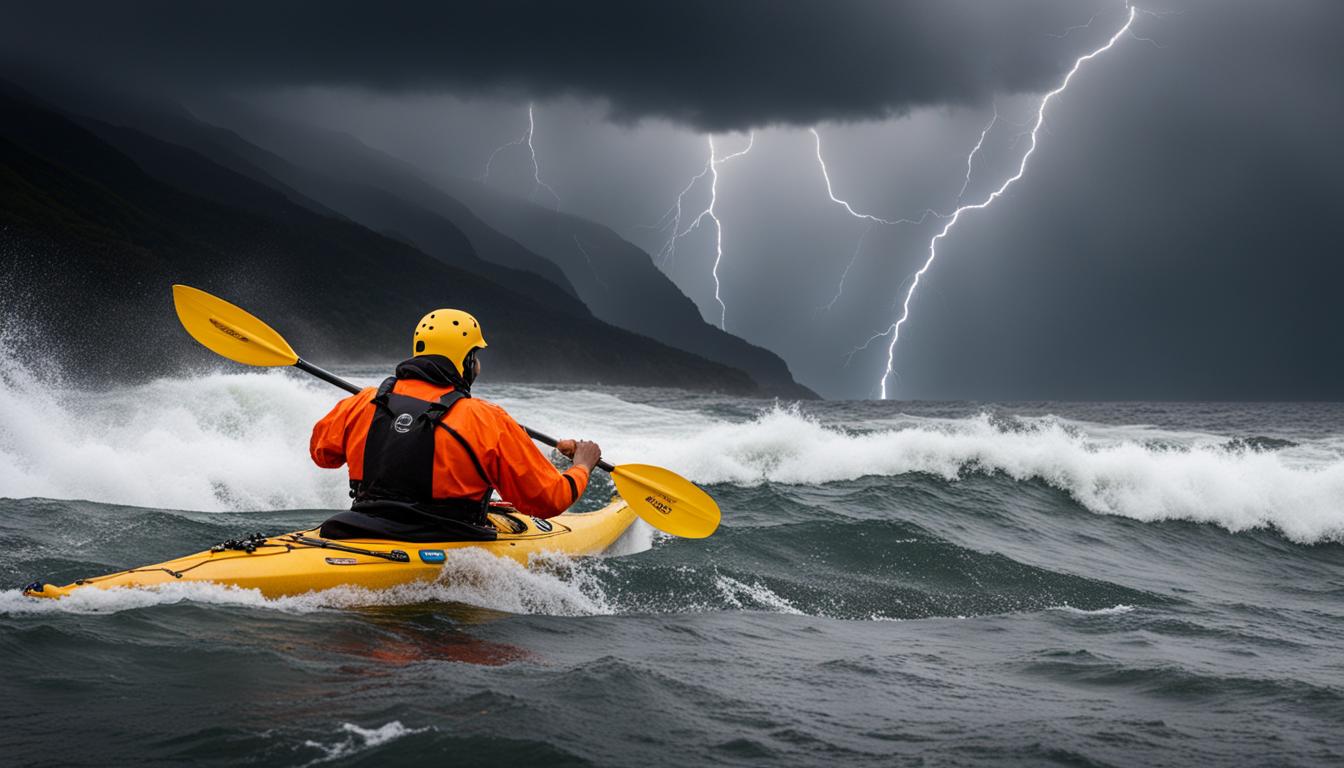When kayaking in stormy weather, it is important to have the right protective gear to ensure your safety and comfort. The unpredictable nature of storms calls for proper preparation, and having the right gear can make a world of difference. Here, we will discuss the essential storm gear for kayaking and the appropriate attire to keep you safe and dry.
Key Takeaways:
- Invest in storm-resistant kayaking gear to protect yourself from harsh weather conditions.
- Choose a drysuit or wetsuit to keep yourself warm and dry in stormy weather.
- Ensure your footwear provides good traction and is water-resistant for better stability.
- Wear a helmet to protect your head from potential impact during rough conditions.
- Consider wearing gloves to maintain grip and protect your hands from cold temperatures.
Kayaking in Stormy Weather: Lightning Safety
When kayaking in stormy weather, it is crucial to be aware of lightning safety. Thunderstorms can present a significant risk to paddlers, and it is important to take necessary precautions. Here are some key points to remember:
1. Monitor the Weather Forecast
Before heading out on a kayaking trip, always check the weather forecast for any signs of thunderstorms or lightning activity. If there is a high chance of storms, it is advisable to postpone your outing to a safer time.
2. Seek Shelter as Soon as Possible
If you are already on the water and notice signs of an approaching thunderstorm, it is essential to seek shelter immediately. Look for a sturdy building or a designated lightning shelter on land. Avoid seeking shelter under tall trees or open structures as they can attract lightning.
3. Stay Low in Your Kayak
If it is not possible to reach shelter in time, stay low in your kayak to minimize your exposure to lightning strikes. Sit in the middle of the kayak, away from any metal components, and avoid touching the water. Keep your paddle down and away from your body.
4. Wait It Out
Once you have found shelter or positioned yourself low in the kayak, wait for the thunderstorm to pass before continuing your kayaking journey. Lightning can travel long distances, so it is important to wait for a safe period of time after the last observed strike before venturing back onto the water.
Remember, lightning is a serious threat during stormy weather and should never be taken lightly. By being proactive, monitoring the weather, and following these safety measures, you can help ensure a safer kayaking experience even in adverse conditions.
Table: Lightning Safety Tips for Kayaking
| Lightning Safety Tips | Description |
|---|---|
| Monitor the Weather Forecast | Check for signs of thunderstorms before starting your kayaking trip. |
| Seek Shelter | If a thunderstorm approaches, find a safe shelter away from tall trees and open structures. |
| Stay Low in Your Kayak | Minimize your exposure to lightning strikes by sitting low in the middle of your kayak. |
| Wait It Out | Wait for a safe period of time after the thunderstorm passes before continuing your kayaking journey. |
Safety in Wind and Waves
When kayaking in stormy weather, the presence of strong winds and rough waves can make your paddling experience challenging and potentially dangerous. To ensure your safety and navigate these conditions effectively, it is crucial to be prepared and take necessary precautions. Here are some key tips for safety in wind and waves:
1. Choose the right kayak
Before heading out into stormy weather, make sure you have a kayak that is suitable for rough conditions. Look for a sturdy, stable kayak with good maneuverability. It should be designed to handle strong winds and waves without compromising your balance and control.
2. Check the weather forecast
Prior to your kayaking trip, always check the weather forecast for any warnings or advisories related to high winds or rough seas. Stay updated on the current weather conditions and plan your trip accordingly. If the forecast indicates severe weather, it is best to reschedule your kayaking adventure for a safer time.
3. Dress appropriately
Wearing the right clothing can make a significant difference in your comfort and safety while kayaking in windy and wavy conditions. Opt for lightweight, quick-drying materials that provide insulation and protection from the elements. Consider wearing a wetsuit or drysuit to keep you warm even if you get wet.
4. Practice proper paddling techniques
When paddling in wind and waves, it is important to use proper techniques to maintain stability and control. Keep a low center of gravity, engage your core muscles, and use a relaxed grip on the paddle. Maintain a steady rhythm and paddle on the side facing the wind to reduce the impact of gusts.
5. Be cautious of hazards
In stormy weather, wind and waves can create additional hazards such as floating debris or submerged obstacles. Keep a lookout for any potential dangers and navigate around them safely. Be mindful of strong currents that may be present in choppier waters.

| Essential Wind and Wave Safety Gear | Description |
|---|---|
| Personal Flotation Device (PFD) | A PFD is an essential safety item that should be worn at all times while kayaking. It provides buoyancy and can potentially save your life in the event of capsizing or getting swept away by strong currents. |
| Spray Skirt | A spray skirt is designed to keep water out of the cockpit, preventing it from filling up with waves or rain. It helps to keep you dry and maintain control of your kayak. |
| Paddle Leash | A paddle leash attached to your kayak and paddle ensures that your paddle stays with you even if you drop it. This prevents you from losing your paddle in rough conditions and allows for quick recovery. |
| Tow Line | A tow line is useful in case you or a fellow paddler needs assistance. It allows you to tow or be towed safely in challenging conditions. |
| Whistle | A whistle is a simple yet effective tool for attracting attention in an emergency. It can be used to alert others if you need help or to communicate your position in low visibility conditions. |
By following these safety tips and being well-prepared, you can navigate wind and waves with confidence while kayaking in stormy weather. Remember that safety should always be your top priority to ensure an enjoyable and risk-free paddling experience.
Basic Safety Gear
When venturing out for a kayaking adventure in stormy weather, it is crucial to have the right safety gear to ensure your well-being. In addition to the essential items mentioned earlier, there are some basic supplies that every kayaker should have in their stormy weather outfit. These items can greatly enhance your safety and preparedness during challenging conditions.
1. Navigation and Communication Devices
Having reliable navigation and communication devices is key when kayaking in stormy weather. GPS devices or waterproof maps can help you stay on course and navigate safely. Additionally, a waterproof phone case or marine radio can be invaluable for emergency communication or calling for assistance if needed.
2. Flares and Whistles
Flares and whistles are essential for signaling for help in case of an emergency. Flares can be seen from a distance and attract attention, while whistles can be used to alert nearby boaters or rescuers. Make sure to store these items in a waterproof container and keep them easily accessible in case of an emergency.
3. Safety Leash
A safety leash is a valuable tool for stormy weather kayaking. It helps to keep your paddle secure and attached to your kayak, preventing it from floating away if you capsize or lose your grip. This can be especially important in rough conditions where it may be challenging to retrieve a loose paddle.
4. Extra Gear and Clothing
It is always recommended to have spare gear and clothing in case of unexpected circumstances. This can include an extra set of dry clothes, a dry bag to keep them in, and additional layers to stay warm. It is also a good idea to pack extra snacks and water to ensure you stay hydrated and energized during your kayaking trip.
| Item | Description |
|---|---|
| Navigation and Communication Devices | GPS devices, waterproof maps, waterproof phone case, marine radio |
| Flares and Whistles | Flares, whistles, waterproof container |
| Safety Leash | Leash to secure paddle to kayak |
| Extra Gear and Clothing | Spare clothes, dry bag, additional layers, snacks, water |
By ensuring you have these basic safety gear items, you can be better prepared to handle the challenges that may arise while kayaking in stormy weather. Remember to always prioritize your safety and be aware of your surroundings. With the right gear and cautious approach, you can have an enjoyable and safe kayaking experience even in adverse conditions.

Conclusion
When embarking on a kayaking adventure in stormy weather, it is essential to prioritize safety and be equipped with the right gear. Personal Flotation Devices (PFDs), bilge pumps, float bags, and backup paddles are some of the essential items for stormy weather kayaking. Additionally, having the appropriate clothing, first-aid kits, and rescue gear can enhance safety and preparedness.
Remember to check the weather forecast, be aware of lightning safety, and take precautions when encountering rough conditions. By choosing the right protective gear and following proper safety guidelines, you can enjoy your kayaking adventure in stormy weather while staying safe and comfortable.
In summary, being storm ready requires having the necessary kayaking essentials. Properly fitted PFDs ensure flotation and safety, while bilge pumps and float bags help manage water in your kayak. It’s always a good idea to have backup paddles in case of breakage or loss. Wearing appropriate clothing and keeping a first-aid kit on board can provide added protection and peace of mind. Lastly, having rescue gear such as tow lines and signaling devices can be crucial in emergencies.
So, whether you’re a seasoned kayaker or an enthusiast setting off for your first stormy weather adventure, make sure you’re equipped with the right kayaking gear. By being well-prepared and following safety guidelines, you can navigate adverse weather conditions with confidence and enjoy the thrill of kayaking while safeguarding your well-being.
FAQ
What protective gear do I need for kayaking in stormy weather?
Personal Flotation Devices (PFDs), bilge pumps, float bags, and backup paddles are essential for stormy weather kayaking. Additionally, having appropriate clothing, first-aid kits, and rescue gear is important for safety and preparedness.
How should I prioritize safety in stormy weather?
When encountering rough conditions, it is crucial to make informed decisions and prioritize safety. This includes checking the weather forecast, being aware of lightning safety, and taking precautions to handle wind and waves.
What should I do to ensure lightning safety while kayaking in stormy weather?
It is important to be aware of lightning safety when kayaking in stormy weather. Stay away from open water and seek shelter if you hear thunder or see lightning. Avoid tall objects and metal, and do not hold onto metal objects in the boat.
How can I handle wind and waves while kayaking in stormy weather?
Wind and waves can be challenging for kayakers in stormy weather. It is important to prioritize safety and make informed decisions. Paddle close to shore, use a low and wide stance to maintain stability, and avoid areas with strong currents or breaking waves.
What other safety gear should I have for kayaking in stormy weather?
In addition to the essential gear mentioned earlier, there are other safety items to consider. These include navigation tools, a whistle or signaling device, a towline or throw bag, and a fully charged cell phone or communication device.





